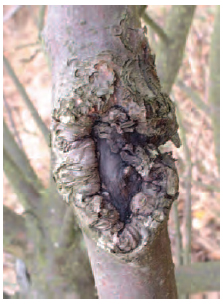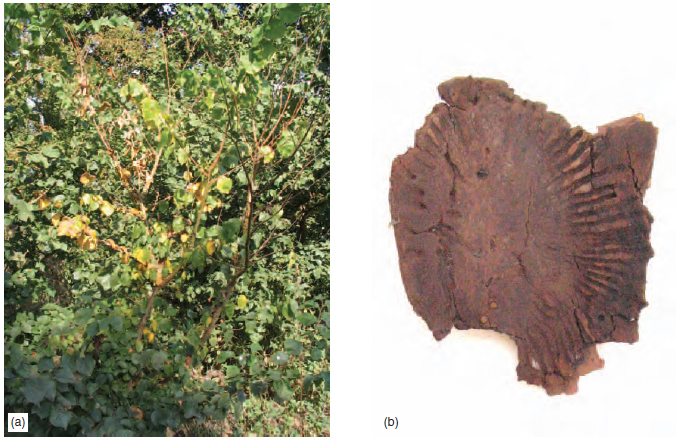Stem diseases
Content
Grey mould (Botrytis cinerea) This fungus is classified in the Deuteromycota group of fungi. Damage: This disease is most commonly recognized by the fluffy, lightgrey fungal mass which follows its infection. In lettuce, the whole plant rots off at the base. The plant turns yellow and dies. In tomatoes, infection in damaged side shoots, and yellow spots (ghost spots) on the unripe and ripe fruit are found. In many flower crops, e.g. chrysanthemums, infected petals show purple spots which, in very damp conditions, lead to mummified flower heads. This disease may affect many crops. Life cycle and spread: Grey mould normally requires wounded tissue for infection, which explains its importance in crops which are de-leafed, e.g. tomatoes, or disbudded, e.g. chrysanthemums. Damp conditions are essential for infection and spore production. The millions of spores are carried by wind to the next wounded surface. Black sclerotia, about 2 mm across, produced in badly infected plants, often act as the overwintering stage of the disease after falling to the ground, and are particularly infective in unsterilized soils on young seedlings and delicate plants, e.g. lettuce. Control: Preventative control may involve soil sterilization. Strict attention to greenhouse humidity control (particularly overnight) reduces the dew formation which is so important in the organism’s infection. Cutting out of infected tissue is possible in sturdy stems, e.g. in tomatoes. Amateur gardeners at present have no effective chemical control against this disease. The professional grower has two protectant fungicide ingredients, iprodione and chlorothalinal. As well as being sprayed, iprodione can also be applied as a paste to cut plant surfaces.
This fungus belongs to the Ascomycota group of fungi. Damage: This fungus causes sunken areas in bark of both young and old branches of ornamental Malus, apples or pears (see Figure 15.10). Poor shoot growth is seen, and the wood may fracture in high winds. Life cycle and spread: The fungus enters through leaf scars in autumn or through pruning wounds during winter. Care is therefore necessary to prevent infection, particularly in susceptible apple cultivars, e.g. ‘Cox’s Orange Pippin, by avoiding pruning in damp conditions. Spread is by rain splash. Control: Removal of cankered shoots may be necessary to prevent further infection, while in cankers of large branches cutting out of brown infected tissue may allow continued use of the branch. Removed tissue should be burnt. Amateur and professional horticulturists may apply a spray of copper (Bordeaux solution) at bud burst (spring) and leaf fall (autumn) to prevent entry of germinating spores. Dutch elm disease (Ophiostoma novo-ulmi) This fungus belongs to the Ascomycota group of fungi. Damage: The first symptom of this disease is a yellowing of foliage in one part of the tree in early summer. The foliage then dies off progressively from this area of the tree, often resulting in death within three months. Trees that survive 1 year’s infection may fully recover in the following year. All common species and hybrids of elm growing in Great Britain are susceptible to the disease (see Figure 15.11).
Life cycle and spread: The causative fungus lives in the xylem tissues of the stem, and produces a poison that results in a blockage of xylem vessels, causing the wilt that is observed. Associated with this disease are two black and red wood-boring species of beetle, Scolytus scolytus (5 mm long) and Scolytus multistriatus (3 mm long). These beetles bore into elm stems leaving characteristic ‘shot holes’. Eggs are then laid, and a fan-shaped pattern of galleries is produced under the bark by the larvae. Later, as adults, they emerge from the wood, carrying sticky asexual and sexual spores of Dutch elm disease to continue its spread to other uninfected elms. Graft transmission of the disease from tree to tree by roots commonly occurs in hedge-grown elms. Control: For the professional horticulturist, the cost of preventative control on a large number of uninfected trees is uneconomical. However, high pressure injection of a systemic fungicide such as thiabendazole which travels upwards through the xylem tissues has proved successful in some cases. Selections of hybrid elms have proved to have high levels of resistance. Examples are the Dutch/French cultivar ‘Lutéce’ with a complex parentage; the Italian cultivar ‘Planio’ with resistant Siberian Elm male parentage; and the American ‘Princeton Elm’ which has shown resistance since the 1920s. The European White Elm (Ulmus laevis) exhibits a resistance to the vector beetles, not the fungus itself. After an estimated 80 per cent removal of the elm population in the UK since the 1970s by Dutch Elm Disease there has been an understandable lack of confi dence in planting elms of any species or cultivar around the countryside, especially the English elm. However, there is a growing realization that the native elm contributes considerably to plant and animal biodiversity in the UK. For example, the elm maintains one lichen species (Orange-fruited Elm lichen) and one butterfly (the White letter Hairstreak butterfly) which are both wholly dependant on the elm. Bleeding Cankers (Phytophthora species) In recent years the following species have been reported on a range of trees: horse chestnut and sweet chestnut affected by P. cambivora, and Oak, beech and tulip tree affected by P. ramorum and P. kernovii. Symptoms of the problem involve a dark ooze coming from the bark. After peeling away the outer bark, deep red, dead patches of inner bark are seen, often with a sharp distinction between dead and living bark. Oaks may be suddenly killed by P. ramorum. Control is at the moment limited to scraping away the outer bark in hot weather to allow drying and healing of tissues. |
||||||||||||||||||||||||||||






